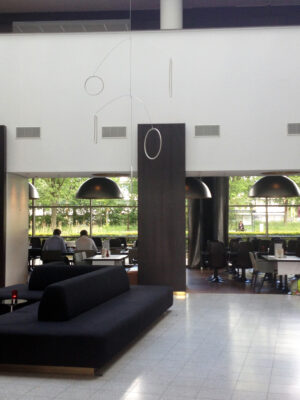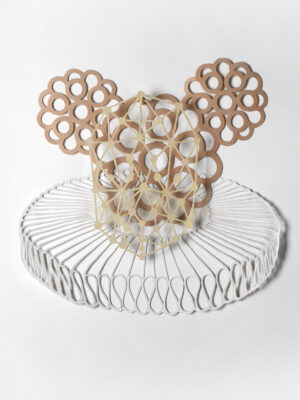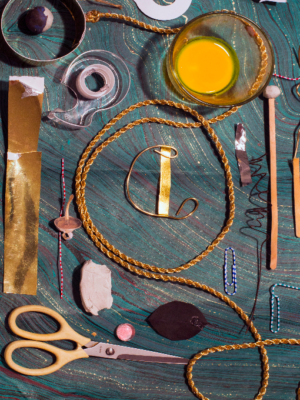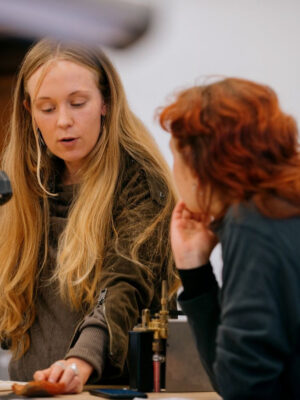Masterfully thrown from creamy Limoges porcelain and encased in an array of carefully formulated celadon-style glazes, Judith Bloedjes’ cyclical ceramics reimagine the stark whites and regimented forms of utilitarian, minimalist design. Her works utilise rounded, organic, porcelain forms and serene silver contours to embrace the softness of the human body. Although her work centres emptiness, with the repeated motif of the circle or halo, there is nothing hollow about experiencing Bloedjes’ works, which range from energetic choreographies of churning bodies punctuated by unblemished porcelain loops, to vessels with odd slumps and lumps, each made individual by its idiosyncrasies, to enormous, tranquil porcelain mobiles that gently drift with the movement of the air.
The serenity and subtlety of Bloedjes’ works are neither accident nor artifice. To the artist, tranquillity is an embodied practice—a lens through which to consider the world and allow it the space and attention to resonate with us. The absence is the substance. The skin framed by the openings of Bloedjes’ colliers, the inviting vacancy of her vessel forms, the cool Dutch light filtering through paper-thin translucent porcelain, the architectural reliefs of two marble columns about to kiss each other—the frame elevates the painting. It is just as illuminating to look through Judith Bloedjes’ pieces as it is to look at them.
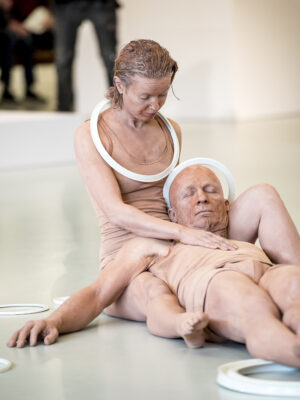
REBECCA SCHENA (RS): We are very excited to see your exhibition Poetic Ceramics at CODA Apeldoorn. Can you walk me through the process of pairing completed ceramic pieces with ‘in-progress’ sketches and material experiments for the exhibition?
JUDITH BLOEDJES (JB): I decided to show the tests and the sketches because, apart from being an artist, I am also a craftswoman. I make everything myself in my studio and prefer to control the whole process. I make my own glazes—the glossy glass layers over the porcelain—which are composed of raw materials based on recipes I developed through a chemical process. I do this so that I can bring out the right transparency and nuances of whiteness. I think that this process, represented by tests and recipes, is interesting for the viewer to see, a kind of peek behind the scenes.
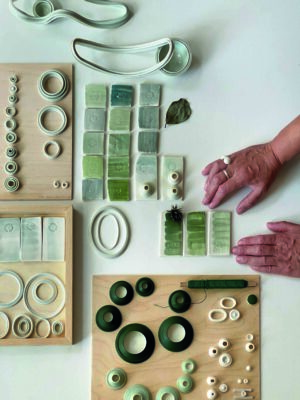
RS: Do you see a link between the performances you choreograph around your ceramic pieces and the precise physical movement involved in the creation of the pieces themselves?
JB: Yes, choreography is about forms. You can have dancers move angularly, but also fluidly, or in harmony, or thrusting upwards, or low to the ground. For me, it is the same, in essence. Whether I make a choreography for a dance or a piece of jewellery or a wall object, it is all about the harmony of the entire work.
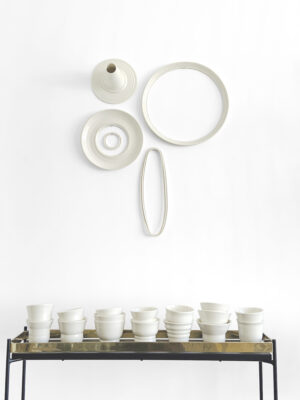
RS: I love your quote included in the statement for Poetic Ceramics: ‘Sometimes the hands come up with different ideas than the head.’ How do you view this relationship between your mind and body as you work?
JB: Between the head and the hands is the heart. The love for beauty creates a dialogue between the head and the hands.
RS: In your book, Poetic Ceramics, you recall the process of learning to throw precise cylinders under the strict guidance of your teacher, Mister H. Breuker, who would—rather ruthlessly it seems —slice each thrown cylinder in half to spot any inconsistencies. With the technical mastery that you have developed, do you find it challenging to leave room for mistakes?
JB: I think it is important that my work shows that it is handmade. All the porcelain pieces are unique, shaped by hand, and all the silver has passed through my hands,w in my workshop. It is not production work and I want you to see that. Sometimes I get an assignment for reproduction work and then the conversation between the head and the hands doesn’t take place and I’m more of an enforcer, which I find difficult. Good gold or silversmiths sometimes criticise my soldering. It could be tighter. But I find the fact that I ‘sculpt’ with silver charming; it makes you see that it is human work. Because porcelain is an isolator and takes heat away, I have to solder at a higher temperature than when you solder silver without porcelain in between. I also spend much longer on soldering because the porcelain needs to be heated and cooled down slowly; cold air frightens it and causes it to break. There is beauty in craftsmanship, human work and imperfection.
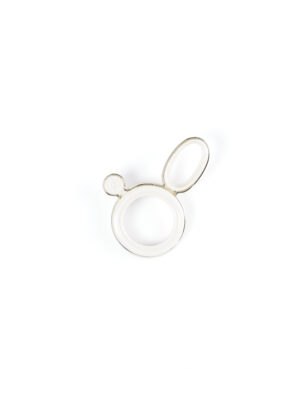
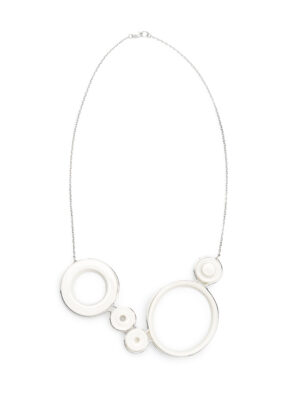
RS: I often feel alienated by the stark monumentality of minimal artworks by artists such as Sol LeWitt or Carl Andre. Your pieces borrow from the same minimal, utilitarian tradition, but feel imbued with warmth and comfort. How do you achieve this sense of intimacy?
JB: I feel the same way. I feel very flattered to be compared to these great artists, however, their work is a bit cool in appearance and is often very geometric. In my work, there is certainly an organic, warm element to the ‘frame’ formed by the lines of silver and the relief of the porcelain curves. I once calculated that the proportions of my work corresponded to the golden ratio, the harmonious proportions achieved through ‘the power of limits.’ I think this ‘sense of intimacy’ that you describe as warmth and comfort has something to do with those familiar proportions, although I have not intentionally used those calculations for a long time—now it is more of a subconscious need for balance.
RS: If the pottery wheel did not innately create circles and cylinders, do you think that the circle would have come to be as central to your work as it is? Does your appreciation of the symbolism of the circle derive from the process, or does the process lend itself to the expression of an existing appreciation?
JB: I like the infinity of the circle and the earthiness of the material, but if I were to end up on a deserted island with no porcelain commodities, I think I would still carve the circle from stone or turn it from wood, whichever material was available.
RS: Almost all of your pieces include an inner, hollow orifice so that even your flattened circles are vessel-like. What is the significance of this central opening?
JB: When I first began working with porcelain jewellery, I saw the circle as a frame and created openings to make the skin visible. In traditional jewellery, the diamond or the ruby gets the leading role, but with the openings I sculpt, the focus is on the skin of the wearer or the textile of their clothing. It is as if the jewellery says ‘see me!’ Just as a good frame makes you look at the painting and creates an interior and exterior space, elevating the work, I aim to do the same with my jewellery.
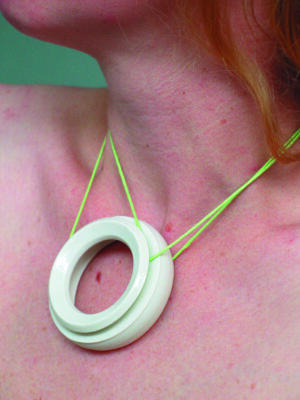
RS: What can tranquil objects offer us in our hectic global context?
JB: A breath of fresh air. Peace, quiet and allowing the balance of the object to resonate with us so that we can experience balance internally.
